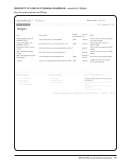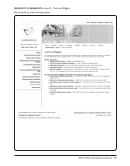104 · Survey Results: Survey Questions and Responses
Making decisions about who should have
access to more informal social networking
Web tools like blogs, giving up some
control over what is posted. O
Keeping up with high user expectations
when library’s staffing and technical
resources are limited.
SC
Many librarians are rooted in traditional
modes of communication and refuse to
explore or recognize the benefits of new
tools. We still have many people who
think users should come to us, rather than
us going to them.
SB
The time to learn and keep up with
the new tools is challenging. Training
opportunities exist, but the real learning
takes place when people actually use
the tools — which takes a great deal of
time. Fortunately, we have a number of
librarians (both new and experienced)
who actively use the new technologies in
their lives and have been quick to jump
onboard and create new initiatives.
T, ST, KU
Determining which social software users
think are appropriate for communicating
with librarians and getting research
assistance.
O
Need the appropriate technology.
TC
Need adequate human resources to
extend services. ST, SC
Policy considerations.
O
Not enough time to learn and do.
T, ST
IT support.
ST
Continuing learning curve — need to
keep up to date. ST, KU
Other initiatives are more pressing at this
time (competing for staff time). CP
Perception of “difficulty,” “irrelevance,”
and/or “lack of time” by staff.
T, SB
Integration with “traditional” services.
CP
Speed of product life cycle:
Blogs -Expired
Facebook -Tired
Twitter -Wired
KU
Policies: Providing conduits for content
created outside of the agency requires the
ability to ensure compliance with agency/
government policies, procedure, laws,
executive orders, etc. allowing access to
non-agency created material must comply
with the strictures of what can and can
not be done on a dot gov domain. The
pre-publication moderation required is a
resource issue for engaging in publication
of user-generated content. O
Terms of Service Agreements: The
typical terms of service agreements for
social software vendors and Web sites
were written for individuals rather than
government agencies. Federal government
agencies may not be able to agree to
the indemnity clauses that these TOS
agreements usually contain. Modifying the
agreements takes time and resources, and
a willingness on the part of the vendor/
Web site to agree to special terms. O
Security: If these emerging software
applications have to be hosted at the
Library and are not part of the Library’s
technical architecture they have to
go through a formal certification and
accreditation process to ensure that they
will not adversely impact existing Library
systems. This impacts the timeline for
implementation.
SP
Making decisions about who should have
access to more informal social networking
Web tools like blogs, giving up some
control over what is posted. O
Keeping up with high user expectations
when library’s staffing and technical
resources are limited.
SC
Many librarians are rooted in traditional
modes of communication and refuse to
explore or recognize the benefits of new
tools. We still have many people who
think users should come to us, rather than
us going to them.
SB
The time to learn and keep up with
the new tools is challenging. Training
opportunities exist, but the real learning
takes place when people actually use
the tools — which takes a great deal of
time. Fortunately, we have a number of
librarians (both new and experienced)
who actively use the new technologies in
their lives and have been quick to jump
onboard and create new initiatives.
T, ST, KU
Determining which social software users
think are appropriate for communicating
with librarians and getting research
assistance.
O
Need the appropriate technology.
TC
Need adequate human resources to
extend services. ST, SC
Policy considerations.
O
Not enough time to learn and do.
T, ST
IT support.
ST
Continuing learning curve — need to
keep up to date. ST, KU
Other initiatives are more pressing at this
time (competing for staff time). CP
Perception of “difficulty,” “irrelevance,”
and/or “lack of time” by staff.
T, SB
Integration with “traditional” services.
CP
Speed of product life cycle:
Blogs -Expired
Facebook -Tired
Twitter -Wired
KU
Policies: Providing conduits for content
created outside of the agency requires the
ability to ensure compliance with agency/
government policies, procedure, laws,
executive orders, etc. allowing access to
non-agency created material must comply
with the strictures of what can and can
not be done on a dot gov domain. The
pre-publication moderation required is a
resource issue for engaging in publication
of user-generated content. O
Terms of Service Agreements: The
typical terms of service agreements for
social software vendors and Web sites
were written for individuals rather than
government agencies. Federal government
agencies may not be able to agree to
the indemnity clauses that these TOS
agreements usually contain. Modifying the
agreements takes time and resources, and
a willingness on the part of the vendor/
Web site to agree to special terms. O
Security: If these emerging software
applications have to be hosted at the
Library and are not part of the Library’s
technical architecture they have to
go through a formal certification and
accreditation process to ensure that they
will not adversely impact existing Library
systems. This impacts the timeline for
implementation.
SP




































































































































































































